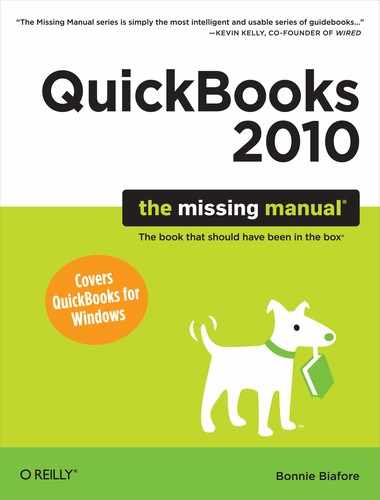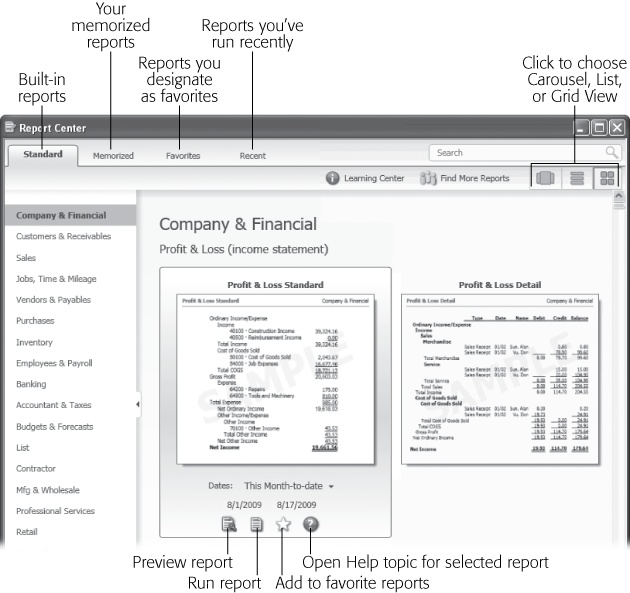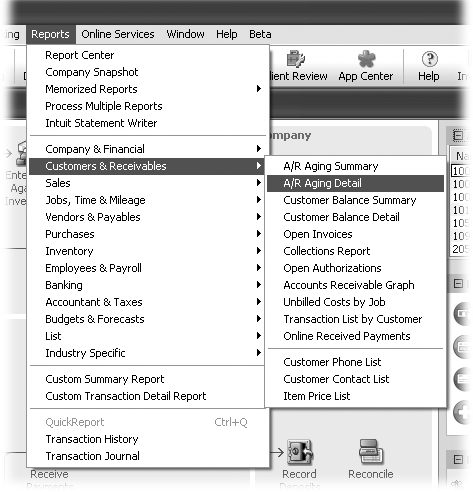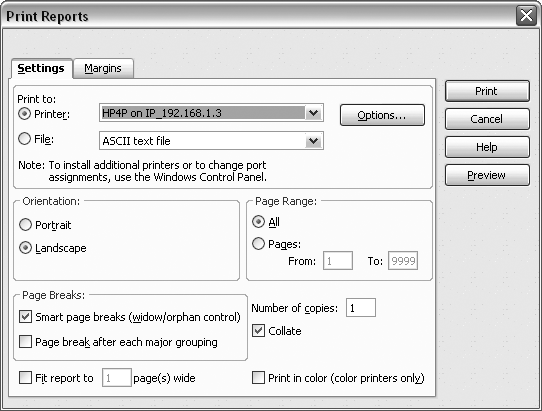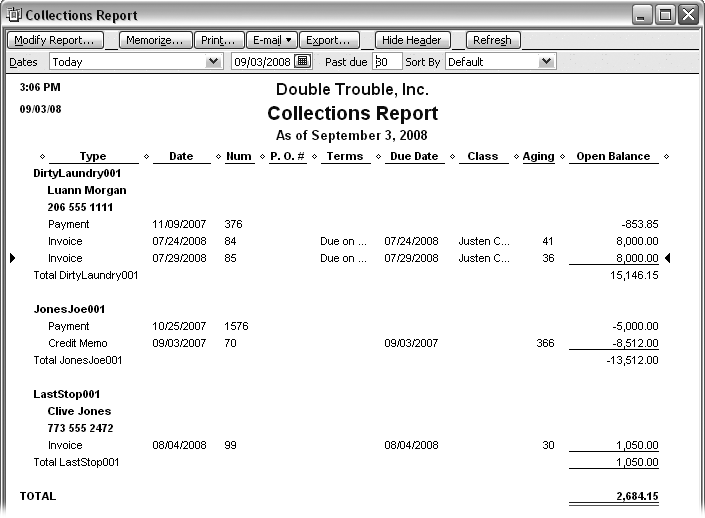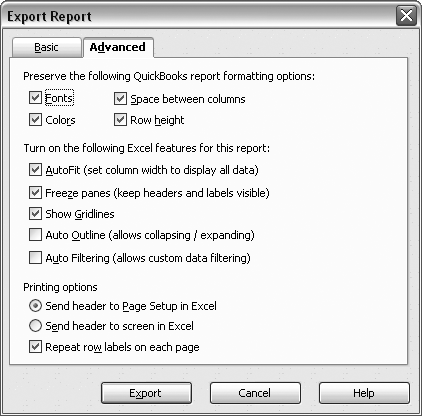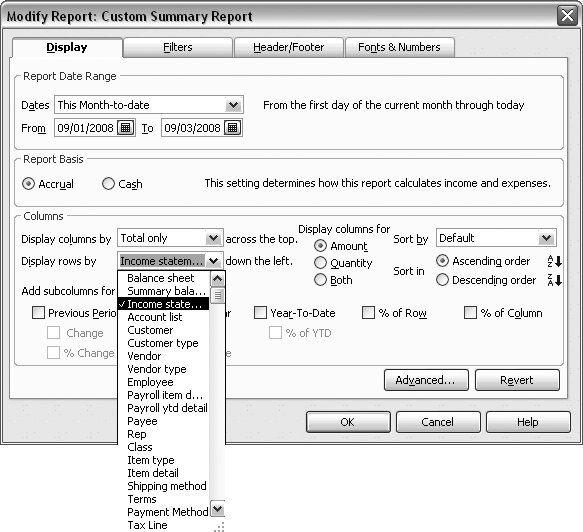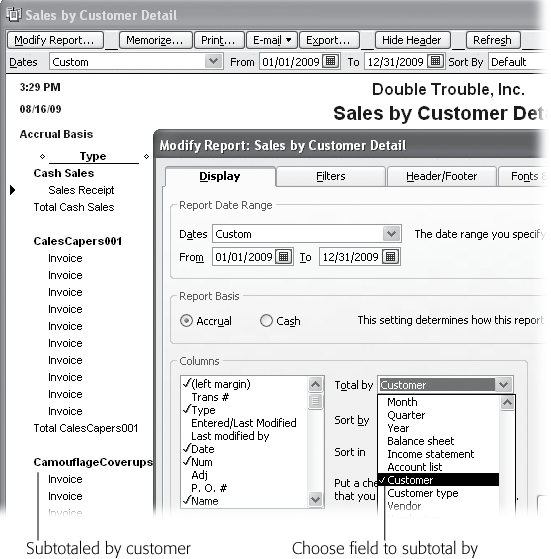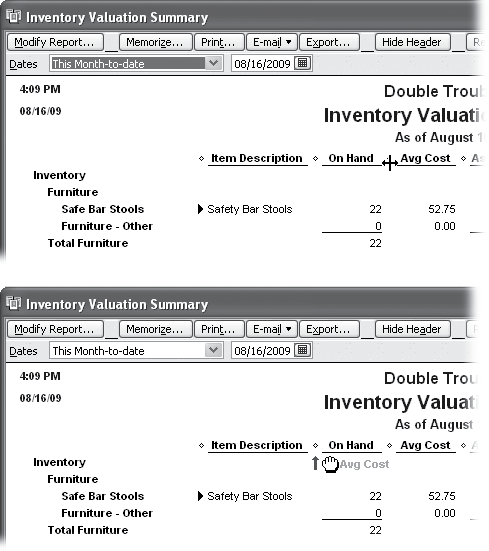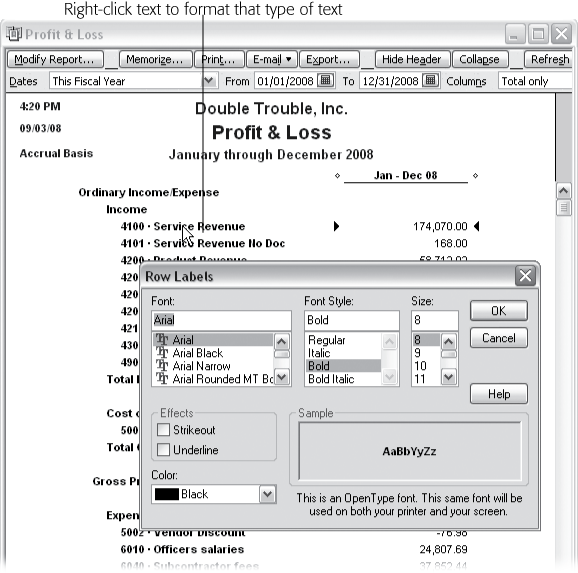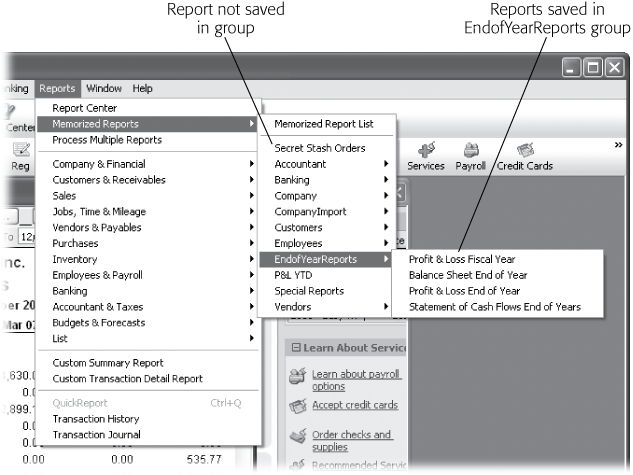Chapter 21. Working with QuickBooks Reports
QuickBooks comes with loads of built-in reports that show what’s going on with your company’s finances. But a dozen report categories with several reports tucked in each category can make for a frustrating search, particularly if you’re new to both business and QuickBooks. The first challenge is knowing what type of report tells you what you need to know. For example, a profit and loss (P&L) tells you how much income and expenses you had, but a balance sheet shows how much your company is worth.
The second challenge is finding the report you want in QuickBooks. After you decide you want to compare the profit of the items you sell, do you look for the corresponding QuickBooks report in the Sales category, Inventory category, or Jobs, Time & Mileage? (If you guessed Jobs, Time & Mileage despite that category’s project-oriented name, you’re right.) On the other hand, the Profit & Loss by Job report appears in both the Company & Finance category and the Jobs, Time, and Mileage category.
The Report Center is a handy way to find the reports you want. In QuickBooks 2010, it has a sleek new look and some cool new timesaving features. Flipping through this book can be even faster, which is why each chapter in this book describes the built-in reports that correspond to the bookkeeping tasks the chapter covers, what they’re good for, and where you can find them.
A third challenge—for even the most knowledgeable QuickBooks aficionado—is that the built-in reports might not do exactly what you want. A date range is off, information that you don’t want shows up, or the data is grouped in ways that don’t make sense for your business. After using QuickBooks for a while, most businesses tweak the program’s built-in reports. This chapter also explains how to customize reports to get what you want.
There’s no point in letting good customization go to waste, so you’ll also learn how to memorize your customized reports, add them to QuickBooks menus for fast access, and even how to exchange particularly handy customized reports between company files.
Finding the Right Reports
If you know what kind of report answers your burning business question, finding the right report can be as simple as dragging your mouse through the Reports menu to a likely category, and then, on the category submenu, clicking the name of the report you want. But if you need help figuring out what a report does and what one looks like, the Report Center could be your new best friend.
On the QuickBooks icon bar, click Report Center (or choose Reports → Report Center). This window shows a clickable list of the same report categories and reports as on the Reports menu. But unlike the menu, the Report Center gives you all sorts of hints for finding the right report. In QuickBooks 2010, the Report Center also offers several new shortcuts for getting to the right report fast, as you can see in Figure 21-1.
On the left side of the Report Center, you’ll initially see built-in report categories. To see the reports in a category, click the category name, like Company & Financial, Sales, or Banking. These categories are the same ones you see on the Reports menu (Running Reports).
Reviewing Reports in the Report Center
In QuickBooks 2010, the Report Center has three ways to view the reports in a category. You can choose the one you want to use, depending on your preference and your computer’s horsepower:
Carousel View, which QuickBooks selects out of the box, is eye candy more than a useful search tool. When you pick a report category with this view, a sample report (one that doesn’t use your company data) appears in the center of the window. In addition to the report title, the question that the report answers appears above the sample, such as “What are my company’s total expenses for each vendor?” for the “Expenses by Vendor Summary” report. Other reports in the category wait in the wings to the left and right of the selected report. Click one of these angled reports to bring it front and center.
Below the report, you can change the date range by clicking the down arrow to the right of the current date range and choosing the new date range. To run the report, double-click the report thumbnail or click the “Display report” icon (a dog-eared piece of paper). To use this view, click the Carousel View icon (which looks like a slide projector if you use you’re imagination) in the upper-right corner of the Report Center toolbar.
List View is your best bet when you want hints about the right reports and also want to get to those reports quickly. Select a category, and the titles of the category’s reports and the questions they answer appear in a space-saving list. When you select a report, the date range and report-related icons appear below the title, which you’ll learn about shortly. To use this view, click the List View icon, which looks like three horizontal bars.
Grid View, shown in Figure 21-1, displays small thumbnails of each type of report in the selected category. To see more reports in the category, scroll down. When you select a report, the date range and report-related icons appear below the title. Click the Grid View icon, which looks like four small boxes in a grid, to display this view.
Tip
If you don’t see the kind of report you want, you may not have to customize a report yourself. The Reports Library within the online Intuit Community has dozens of reports and spreadsheets that you can download. In the Report Center to the left of the view icons, click the Find More Reports link, which opens a browser window to the Reports library. Click the category of report you want, such as Banking, Customers, or Vendors. To download reports, simply click the link in the Download column. If the link says something like Download Banking Reports, you’ll download several banking reports. A link like Accounts With No Tax Line Assignments.QBR downloads a single report (in this example, one for identifying accounts not assigned to tax lines). See Importing Report Templates for how to import reports into your company file.
Working with Reports in the Report Center
When you select a report in the Report Center, you’ll see the date range for the report and icons for performing report-related tasks:
Date range. QuickBooks displays the current date range for the report and the dates the range represents, for example, This Fiscal Year and “1/1/2010 12/31/2010”. To change the date range before you run the report, click the date range (This Fiscal Year, in this example) and then choose the new range from the drop-down list. (See Date Ranges to learn about the date ranges you can choose from.)
Preview a report. Click the icon that looks like a dog-eared piece of paper with a magnifying glass to see a sample of the report you’ve selected. These samples are only helpful for built-in reports that QuickBooks provides. On the Memorized tab of the Report Center, the report icons and the samples say nothing more than “Memorized Report”. You have to run the report to see what it looks like.
Run a report. The icon that looks like a dog-eared piece of paper has a tool tip that says “Display report”. If you click this icon, QuickBooks runs the report and displays it in a report window. When the report is open in a report window, click Modify Report in the window tool bar to make changes to the report (Customizing Reports).
Learn more. If you want to know more about a report and how you can customize it, in the Report Center, select the report and then click the “Learn more about this report” icon (a blue circle containing a white question mark). QuickBooks opens the Help topic for the report, which gives hints about how to use the report and how to customize it. If you click this icon for a memorized report, QuickBooks opens the " Work with memorized reports” Help topic.
Finding Frequently-used Reports
In QuickBooks 2010, the Report Center initially displays its built-in reports and the categories to which they belong. However, the Center also offers quick access to reports that you run often:
Memorized reports. If you modify reports to suit your needs, you can memorize them (Memorizing Reports) and run them again and again with all your customized settings already in place. In the Report Center, click the Memorized tab to see your memorized report groups (Running Reports). When you select a group, the window displays the reports within that group.
Favorite reports. QuickBooks 2010 lets you vote for your favorite reports so you can get to them in a jiffy. In the Report Center, the Favorites tab displays all the reports that you designate as your favorites. Whenever you select a report in the Report Center, a “Mark as Favorite” icon (a white star with a yellow border) appears. If the report is one that you run more often than you check email, simply click the icon, and QuickBooks adds the report to the Favorites tab and turns the star yellow to indicate a favorite report.
Recent reports. You can quickly rerun a report you used recently by clicking the Recent tab and then choosing the report you want. For example, if you produced a “Sales by Customer” report a few days ago and need to run it again, on the Recent tab, look below the Last 1-7 days heading, click the report name, and then click the “Display report” icon.
Search. If you don’t know which built-in report you want, you can use keywords to narrow down your choices. For example, if you know you want to see how much equity you have in your company, in the Search box at the upper right of the Report Center, type equity. A Search Results tab appears with a list of reports that include equity, such as Balance Sheet Standard, Net Worth Graph, and Balance Sheet Prev Year Comparison.
Running Reports
QuickBooks tries to atone for any difficulties you might have finding the right reports by scattering commands to run reports throughout the program in windows, menus, and centers. While you’re learning and want to choose from every built-in report that QuickBooks has, stick with the Report Center (described in detail on Finding the Right Reports). When you’re more familiar with what QuickBooks reports do, the Reports menu is the quickest route to running reports, as shown in Figure 21-2. The box on Running Reports gives you a shortcut for when you want to run several reports at the same time.
You can run reports from many location in QuickBooks. Here’s how you run reports depending on where you find them in the program:
The Report Center. Select the report you want to run. If you want to change the date range before you run the report, click the current date range, and then choose the new range on the drop-down list. To run the report, click the icon that looks like a dog-eared piece of paper, as shown in Figure 21-1.
Reports menu. This menu patiently waits in the QuickBooks menu bar. To run a report, choose Reports, and then choose the report category you want (such as Memorized, Company & Financial, or Vendors & Payables). On the submenu that appears (Figure 21-2), choose the report you want to run. (If another submenu appears, drag until you can choose the report you want.) A report window opens to the report you chose.
Favorites menu. In QuickBooks 2010, the Favorites menu is the new kid on the program’s menu bar (Building Your Favorites Menu). If you add a report to the Favorites menu, run the report by choosing Favorites → <report name>.
Icon bar. You can customize the icon bar (Building Your Favorites Menu) to include your all-time favorite reports or a category of reports. To run a report from the icon bar, click the report’s icon.
List windows. In a list window, such as the Chart of Accounts window, Item List window, or Payroll Item List window, click the Reports button at the bottom of the window and then choose the report you want to run on the drop-down list that appears.
Figure 21-2. The Reports menu not only includes built-in QuickBooks reports and reports you memorize; it also launches the Report Center, the Company Snapshot, and contains the Process Multiple Reports command, described in the box on Running Reports.Vendor, Customer, and Employee Centers. In a center toolbar, choose Print or Excel to create a hard copy (Printing and Saving Reports) or to export an Excel file (Exporting Reports) of a Vendor List, Customer List, or Employee List report. To run reports about a specific customer or vendor, open the Customer Center or Vendor Center. Select the customer, job, or vendor to display the information on the right side of the Center’s window. Then, click one of the report links like QuickReport or Open Balance.
Note
Some features on reports should remain consistent for every report that a company generates, such as whether you use cash or accrual accounting. (Accounting Basics—The Important Stuff describes the difference between cash and accrual accounting and why you might choose one or the other.) A QuickBooks administrator can set company-wide report preferences to ensure that reports show financial information correctly and consistently. But even without administrator powers, you can still specify a few settings for the reports and graphs you run. See Preferences That Apply to Every Company Report to learn how to set report and graph preferences.
Some reports take a long time to generate, because they pull data from every corner of the company file. And running your company file in multi-user mode exacerbates the problem. If you’re hunkering down to a report-running session of epic proportions, here are some tips for speeding up your work:
Wait until everyone else has logged out of the company file.
If possible, log into QuickBooks from the computer that contains the company file. Otherwise, log into the fastest computer on your network.
In QuickBooks, switch the file to single-user mode by choosing File → “Switch to Single-user Mode”.
Printing and Saving Reports
In QuickBooks, you can turn any report you create into either a hard copy or an electronic file. If you save a report as a file, you can use it to feed other programs or edit the report in ways that you can’t do in QuickBooks.
Printing a report doesn’t take any imagination. At the top of a report window, click the Print button. In the Print Reports dialog box that opens, QuickBooks has most of the same printing options you find in other programs, as you can see in Figure 21-3.
In the Print Reports dialog box, the Page Breaks section has two checkboxes that control where page breaks are placed in a report:
To add a page break after major sections of the reports like Income and Expenses in a Profit & Loss report, turn on the “Page break after each major grouping” checkbox. When this checkbox is turned off (as it is initially), the report starts a new section on the same page.
To stuff as much report as possible onto the fewest pages, turn off the “Smart page breaks” (widow/orphan control) checkbox. When you do so, QuickBooks prints to the very last line of a page, even if it means that a single row of a section appears on one page with the rest of the section on another. The box on Sorting Reports describes another way to squeeze more report onto a page.
Saving Reports to Files
Intuit gives you three places to transform reports into files. The Print Reports dialog box has an option to create ASCII text files, tab-delimited files, and comma-delimited files. But you can also create comma-delimited files and Excel workbooks by choosing Export in any report window. (The comma-delimited files that you create in both dialog boxes are identical, so you can generate them whichever way you prefer.) Your third option is to print forms or reports as .pdf files.
Here are the three ways you can create files for reports and the differences between them:
Print to file. In a report window, click Print to open the Print Reports dialog box. Just below the Printer option are the File option and a drop-down list, which includes “ASCII text file”, “Comma delimited file”, and “Tab delimited file”. After you choose the type of file and then click Print, QuickBooks opens the Create Disk File dialog box, where you can specify the filename and where you want to save the file.
The ASCII text file format produces a text file that looks like the report, but it uses different fonts and uses space characters to position values in columns. This type of file isn’t suitable for importing into spreadsheets or other programs, but you can use it to store an electronic version of your report.
Export to spreadsheet file. In a report window, click Export to open the Export Report dialog box. In the Export Report dialog box, if you choose to export the report to a new workbook or a worksheet in an existing Excel workbook, click Export to open the report in Excel. If you want to tell QuickBooks how you want to set up the Excel spreadsheet, click the Advanced tab, and choose settings, as shown in Figure 21-5, before you click Export.
If you choose the “a comma separated values (.csv) file” option on the Basic tab and click Export, QuickBooks opens the Create Disk File dialog box, where you can type a file name and choose a location to save the file.
Figure 21-5. The Advanced tab has three sections for setting up a report in Excel. The first section focuses on whether to transfer the fonts, colors, and spacing that you set up in your QuickBooks reports to the Excel workbook. The second section provides checkboxes for turning on Excel features such as AutoFit, which makes columns wide enough to display all the data. The Printing options section can send the report header to the Excel header area (in Page setup) or to the top of the worksheet grid.Save as a .pdf file. To save a report as a PDF (Acrobat) file, run the report. When the report’s open, choose File → Save As PDF. In the “Save document as PDF” dialog box, navigate to the folder where you want to save the file, type the filename in the “File name” box, and then click Save. (File → Save As PDF also works for saving forms like invoices and sales receipts as PDF files. When you tell QuickBooks to email forms, the program automatically creates a .pdf file of the form and attaches it to the email message.)
Email an Excel file or .pdf file. To email a report, in a report window, click Email and then choose “Send report as Excel” or “Send report as PDF”.
Customizing Reports
The report window is teeming with ways to customize reports. Some tools are easy to spot like the buttons and drop-down lists at the top of a report window. But you can also drag and right-click elements in a report to make smaller changes. Here’s where you go to customize a report:
Run custom reports from the Reports menu. If you make it all the way through the QuickBooks report categories without finding the report you want, don’t give up hope. The Reports menu includes two entries for building custom reports from scratch. Choose Custom Summary Report to build a report that displays subtotals by some kind of category. For instance, you could customize a summary report to create an income statement for all customers of a particular type. The Custom Transaction Detail Report lets you customize transaction reports to show exactly the fields you want to see.
As soon as you choose one of these custom reports, QuickBooks opens both the report window and the Modify Report dialog box—because a custom report needs some kind of customization. You can set up the contents and appearance of the report any way you want, as shown in Figure 21-6. For a custom transaction report, the Modify Report dialog box includes a list of fields that you can turn on and off, as well as checkboxes for specifying how you want to sort and total the results.
Figure 21-6. In addition to date ranges, filters, and other customizations (Date Ranges), you can control what QuickBooks displays in the rows and columns of a custom report. The entries in the “Display columns by” and “Display rows by” drop-down lists are the same, so you can set up a report to show your data across or down. A report that uses the same category for both columns and rows doesn’t make any sense, so be sure to choose different entries for columns and rows. The Modify Report dialog box for custom reports also includes checkboxes for comparing values to previous periods as well as showing dollar and percentage differences, like budget versus actual reports do.Report window button bar. Across the top of the report window, the button bar includes the Modify Report button, which opens the all-powerful customization tool—the Modify Report dialog box. The button bar includes other handy customization buttons like Hide Header and Collapse, discussed in the box below.
Report window tool bar. Below the button bar is a customization toolbar, where you can choose the date range, the columns to display, and which column to use for sorting the report’s contents.
Report window. Hidden within the report itself are a few customization features. For example, by right-clicking text in a report, you can format its appearance. Dragging the small diamonds between columns changes the column width and, for detailed reports, you can drag columns to new locations.
Read on to learn about all the techniques available for making a report exactly what you want.
Date Ranges
Different reports call for different date ranges. Financial statements typically use fiscal periods, such as the last fiscal quarter or the current fiscal year. But many companies manage month by month, so sales reports often cover the current month or month to date. Payroll reports span whatever period you use for payroll, whether that’s one week, two weeks, or a calendar month. And tax reports depend on the tax periods required by the tax agencies you answer to.
The best place to choose the date range depends how much report modification you have in mind:
If the date range is the only thing you want to change, the report window toolbar is the way to go. In the Dates drop-down list, choose the preset date range you want, or, in the From and To boxes, pick the starting date and ending date for the report, respectively.
If you plan to change more than the date, click Modify Report instead. In the Modify Reports dialog box, the Report Date Range section includes the same date-setting features as the report window toolbar—as well as several additional tabs and sections for every other type of customization.
QuickBooks has two dozen preset date ranges that work based on today’s date. For example, if it’s June 15, 2010 and your company uses the calendar year as its fiscal year, This Fiscal Year represents January 1 through December 31, 2010, but Today is simply 6/15/2010. And, if none of these date ranges do what you want, in the report window toolbar, you can set specific start and end dates in the From and To boxes.
The preset date ranges are numerous because they mix and match several types of date ranges.
Durations. Some preset periods represent durations, such as Week, Month, Fiscal Quarter, Fiscal Year, Tax Quarter, and Tax Year. At the extremes, you can pick All to encompass every date in your company file, or Today, which includes only today.
This, Last, and Next. For each duration, you can choose the current period (such as This Fiscal Quarter), the previous period (Last Fiscal Quarter), or the next period in the future (Next Fiscal Quarter).
Full and to-date. You can also pick between a full period and the period up to today’s date. For example, on June 15, “This Month” covers June 1 through June 30. “This Month-to-date” represents June 1 through June 15.
Subtotals
Many of QuickBooks’ built-in reports calculate subtotals. For instance, Profit & Loss summary reports include subtotals by income, cost of goods sold, expenses, and so on. Sales reports by customer subtotal the sales for all the jobs you do for a customer.
When you create a detailed report, such as “Sales by Customer Detail”, the report shows every transaction for that report, and you can subtotal the results in any way that makes sense for that type of report, as shown in Figure 21-7.
Depending on the report you pick, some choices in the “Total by” drop-down list are more appropriate than others. For example, you might decide to subtotal a sales report by Customer Type, Rep, or the Account list to see which types of customer provide the most business, which sales rep makes the most sales, or which income account pulls in the most money. Subtotaling a sales report by Workman’s Comp Code doesn’t make any sense—and QuickBooks isn’t subtle about saying so: The report displays a zero balance and no rows of data.
Tip
When a selection in the “Total by” drop-down list empties your report, choosing a different field might not bring back your report’s contents. Close the report by clicking the report window’s Close button (the X button on the right side of the window title bar). In the Memorize Report box that QuickBooks displays, be sure to click No or you’ll memorize an empty report. Then run the report anew by choosing it from the appropriate category within the Reports menu.
Customizing the Columns in Reports
Some reports start with only one column, but they don’t have to stay that way. Depending on the type of report, you can change the columns that appear in several ways like showing columns for each time period or choosing fields to display in separate columns. Then, if you find that your appetite for columns is larger than your computer screen, you can remove, resize, and reorder the columns.
Adding and removing columns in summary reports
As you manage your business, you’ll want to see results for different date ranges in the reports you generate. For example, during a year, you might create a Profit & Loss report to show your financial status by month, for each fiscal quarter, and for the entire year. If the report window toolbar includes a Columns drop-down list (which it does for summary-type reports), choosing an entry there is the quickest way to change the categories that columns represent (see Figure 21-8). You can make the same choices in the Modify Report dialog box using the “Display columns by” drop-down list.
The Modify Report dialog box provides different comparison checkboxes for each type of report. For example, when you click Modify Report for a Profit & Loss report, you’ll find additional checkboxes to compare results to the previous period, previous year, or the year to date, and to show dollar and percentage comparisons. If you want to focus on the percentage difference between budget and actual values, then turn off the “$ Difference” checkbox.
The Profit & Loss Modify Report dialog box even includes checkboxes for “% of Column”, “% of Row”, “% of Income”, and “% of Expense”. If you generate a Profit & Loss report by quarter and turn on the “% of Row” checkbox, the report shows each quarter’s performance as a percentage of the full year’s results.
Adding or removing columns in detail reports
Reports that show transaction details, such as Profit & Loss Detail or Inventory Valuation Detail, use columns for data fields like Name or Memo. To change the columns that appear in a detail report, in the report window, click Modify Report, and then choose the columns you want to add or remove, as shown in Figure 21-9.
Resizing and moving columns
Some columns seem to use more room than they need, while others truncate their contents. Figure 21-10 shows you how to resize columns or rearrange the order in which they appear.
Sorting Reports
QuickBooks’ built-in reports come pre-sorted, but the order is rarely obvious. When you first generate a report, the Sort By box is set to Default, which means different things for different reports. For example, if you create a “Sales by Customer Detail” report, QuickBooks groups the transactions by customer, but it sorts the transactions for each customer from earliest to most recent. (Unlike Excel, QuickBooks sorts by only one field at a time.)
The fields you can use to sort depend on the report. For the “Sales by Customer Summary” report, you can choose from only two columns to sort by. The Sort By box includes Default and Total. Default sorts the report by customer name in alphabetical order. Total sorts the report by the total sales for each customer, from the smallest to largest dollar amount. On the other hand, the “Sales by Customer Detail” report includes several columns of information, and you can sort by any of them.
If a report is sortable, in the report window toolbar, you’ll see the Sort By box. In the Sort By drop-down list, choose the column to use to sort the report. As soon as you change the Sort By box to something other than Default, the Ascending/ Descending button appears to the right of the Sort By box. (It has the letters A and Z on the left and a blue arrow that points down when the sort order is descending and up when the sort order is ascending.) Clicking this button toggles between sorting in ascending and descending order.
Filtering Reports
Detail reports (the ones that list individual transactions) usually show more information than you want. For example, a “Purchases by Item Detail” report could run page after page, listing your weekly purchases of Turtle Chow. Filtering a report removes transactions that don’t meet your criteria, so you can home in on just the Turtle Chow purchases from Myrtle’s Turtle Mart.
In QuickBooks, you can apply as many filters as you want at the same time. Each filter adds one more test that a transaction has to pass to appear in your report. For example, when you set the date range for a report, what you’re really doing is adding a filter that restricts transactions to the ones that happened between the starting and ending dates. Then, if you want to find the sales for only your corporate customers, you can add a filter based on the Customer Type field.
QuickBooks provides dozens of filters, from the most common, such as dates, items, and transaction types, to the less useful, such as Workmen’s Comp Codes and FOB (that’s “free on board,” discussed on Sales & Customers).
Built-in reports already have filters, but you can customize a built-in report by adding extra filters or editing or removing the existing filters. Here are the steps:
In the report window, click Modify Report and then, in the Modify Report dialog box, click the Filters tab. In the Choose Filter list, choose the field you want to filter by.
Depending on the field you choose as a filter, QuickBooks provides different criteria, one example of which is shown in Figure 21-11.
Using the drop-down lists or options that appear, specify the filter criteria you want to apply.
For instance, if you filter by account, in the Account drop-down list, you can choose a category such as “All bank accounts”, or you can choose “Selected accounts”, and then click each one you want to include. Or you can click a single account. QuickBooks adds the filter to the list of Current Filter Choices.
To remove a filter, in the Current Filter Choices list, select the filter, and then click Remove Selected Filter.
QuickBooks removes the filter from the list.
To edit a filter, in the Current Filter Choices box, select the filter you want to change. In the Choose Filter section, make the changes you want.
Report Headers and Footers
You don’t have complete control over what appears in report headers and footers, but you can choose from several fields common to all of them. For example, fields like Company Name, Report Title, and Date Prepared are options for a header, and page number is one option for footers. To change the header and footer contents for the report you’re working on, in the Modify Report dialog box, click the Header/Footer tab.
Note
To set standards for all report headers and footers, open Report preferences (Preferences for the Reports You Generate) and then set the fields you want.
QuickBooks pulls data from your company file to automatically fill in the header and footer text boxes. For example, if you use a built-in “Sales by Customer Detail” report, the program fills in the Report Title box with—you guessed it—“Sales by Customer Detail”. If you have a more eloquent title for the report, type it in the box.
The Show Footer Information section provides the Extra Footer Line box for typing whatever you want. The text appears in the bottom-left corner of the report page. This text isn’t associated with any field in QuickBooks, so it’s blank unless you type something.
The last checkbox in both the Show Header Information and Show Footer Information sections controls the pages on which the headers and footers appear. To conserve paper, turn off the “Print header on pages after first page” checkbox so QuickBooks includes the header on the first page only. If you want to omit the page number on the first page, turn off the “Print footer on first page” checkbox.
The right side of the Header/Footer tab is the Page Layout section, which lets you position header and footer fields to a very limited extent, as shown in Figure 21-12.
Fonts and Numbers
The fonts you use or the way you display numbers doesn’t change the underlying financial message, but an attractive and easy-to-read report can make a good impression. Just like the fields that appear in the header and footer, you can set QuickBooks’ preferences to assign the same font and number formats for all your reports.
On the other hand, changing fonts directly in a report is quick, and has the added advantage of letting you see exactly what the report looks like with the new formatting, as Figure 21-13 shows.
If you already have the Modify Report dialog box open, click the Fonts & Numbers tab. The Fonts section on the left side of the tab lists the different text elements in your report, such as Column Labels, Company Name, and Transactions. To change a font, select a text element and click Change Font, which opens the same dialog box you get when you right-click the element in the report.
The right side of the Fonts & Numbers tab has options for changing the appearance of numbers. Negative numbers are usually a curse in the financial world, so accountants use several methods to make them stand out. If you’re not sure which style of negative number you like, choose an option and check the number in the Example area. In QuickBooks, you can choose among three ways to show negative numbers:
Normally. This option shows negative numbers preceded by a minus sign, like –1200.00.
In Parentheses. This option places negative numbers within parentheses without a minus sign, for example, (1200).
With a Trailing Minus. This option places the minus sign after the number: 1200–.
Tip
If you use a color printer or display reports on your computer screen, make negative numbers even harder to ignore by turning on the In Bright Red checkbox.
To make big numbers easier to read, in the Show All Numbers section, turn on the “Divided by 1000” checkbox. This removes one trio of zeros from numbers, so that $350,000,000 shows up as $350,000 in a report. And, if a report tends to contain mostly zero values, you can keep the report lean by turning on the “Except zero amounts” checkbox. Turn on the Without Cents checkbox to show only whole dollars.
Memorizing Reports
If you take the time to customize a report to look just the way you want, it’d be silly to jump through those same hoops every time you run the report. By memorizing your modified reports, you can run them again and again with all your customizations just by choosing Reports → Memorized Reports, and then picking the report’s name on the appropriate submenu.
When you memorize a report, QuickBooks remembers the settings—like date range and filter criteria—but not the data itself. So if you memorize a report whose date range is set to This Month, the report shows the results for June when you run the report in June, but shows results for December when you run the report in December.
Here’s how you memorize a report you’ve customized:
Review the report to make sure it has the information and formatting you want.
If you notice later that you missed a setting, you can make that change and memorize the report again.
In the report window, click Memorize.
QuickBooks opens the Memorize Report dialog box, which is small and to the point. If you’re memorizing a standard report, the dialog box contains a Name box and a checkbox for choosing a memorized report group. If you’re rememorizing an existing memorized report, the dialog box contains Replace, New, and Cancel buttons. Click Replace to rememorize the existing report with the new settings. Click New to create a new memorized report from the current one.
In the Name box, type a name that indicates what the report shows, like Deadbeat Payees.
If you want to save the report in a special group, turn on the “Save in Memorized Report Group” checkbox.
You can then choose the group. QuickBooks comes with several built-in groups like Accountant, Company, and Customers, which appear on the Memorized Reports submenu, and shown in Figure 21-14. But you can create your own groups as the box on Running Reports explains.
Click OK to memorize the report.
Voilà—you’re done. If you’re going to use the report over and over, consider adding it to the Favorites menu or to the QuickBooks icon bar (Building Your Favorites Menu), you can run the report by choosing it from the Favorites menu or clicking its icon, respectively.
Tip
The Memorized Report List window comes in handy if you want to edit or delete reports. Choose Reports → Memorized Reports → Memorized Reports List. In the window, select the report you want to work on and then click Memorized Report at the bottom of the window. On the drop-down menu, choose Edit to change the report name or the group where it’s memorized. Choose Delete Memorized Report to obliterate it from the list.
Swapping Reports Between Company Files
Suppose you’re one of several business owners who meet to share ideas. Some of your colleagues rave about the QuickBooks reports they’ve customized, and you’d like to use the reports they’ve created. If they’re willing to share their ideas, you can swap reports by trading report template files.
Report templates contain the layouts, filters, and formatting for memorized reports. Someone can export a memorized report as a report template, and someone else can import that file to save the report in a different company file. For example, if your accountant likes to see information in very specific ways, she can give you a report template file so you can produce the reports she wants to see.
Most of the time, report templates play well between different QuickBooks editions (Premier, Pro, and Enterprise) and from version to version (2008, 2009, and so on). However, here are a couple points to keep in mind:
If you use QuickBooks Pro, you can only import templates that others create. You need QuickBooks Premier edition to export report templates.
QuickBooks patches can affect the compatibility between versions. In that case, you might have to install the most recent QuickBooks update if you want to use someone else’s report templates. (QuickBooks displays a warning if an update or version incompatibility exists with a report template you try to import.)
Exporting a Report
Whether you export one report or an entire group, QuickBooks stores the report settings in a single file with a .qbr file extension (for “QuickBooks report”). Because report templates are meant to move between QuickBooks company files, you don’t have to specify any more than the reports you want to export and the file to which you want to export them:
Choose Reports → Memorized Reports → Memorized Report List.
QuickBooks opens the Memorized Report List window.
Select the report or memorized group that you want to export.
For example, if your customized reports are all memorized in the Special Reports memorized group, select Special Reports.
Click Memorized Report, and then choose Export Template.
QuickBooks opens the “Specify Filename for Export” dialog box, which is nothing more than a Save As dialog box that automatically sets the file type to QuickBooks Report Files (*.QBR). The program also automatically applies the report or group name as the name in the “File name” box. If you want to use a different name, say to add the date you exported the reports, in the “File name” box, type the new name.
Navigate to the folder where you want to save the template.
For example, your folder for QuickBooks export files.
Click Save.
QuickBooks saves the settings for the report or reports to the file. The next section tells you how to import a report template.
Importing Report Templates
Importing reports from a template file is even easier than exporting reports. In the Memorized Report List window (choose Reports → Memorized Reports → Memorized Report List), click Memorized Report, and then choose Import Template. QuickBooks opens the Select File to Import dialog box with the “Files of type” box set to “QuickBooks Reports Files (*.QBR)”. All you have to do is navigate to the folder that contains the report template file and double-click the filename (or select the filename and then click Open).
Note
If you try to import a report or group with the same name as a report or group already in your company file, QuickBooks displays a warning and recommends that you change the name of the report or group that you’re importing. Click OK and remember to change that name before you save the imported report or group.
Depending on whether you’re importing one report or a group, QuickBooks opens a different dialog box:
Single report. QuickBooks opens the Memorize Report dialog box. As you would if you were memorizing a custom report of your own design, in the Name box, type the name you want for the report, and if you wish, choose a Memorized Report Group.
Report group. When you import a report group, the program opens the Import Memorized Reports Group With Name dialog box. QuickBooks fills in the Name box with the group name from the original company file, but you can type a different name. When you click OK, the program memorizes all the imported reports with their original names in the new group in your company file.
